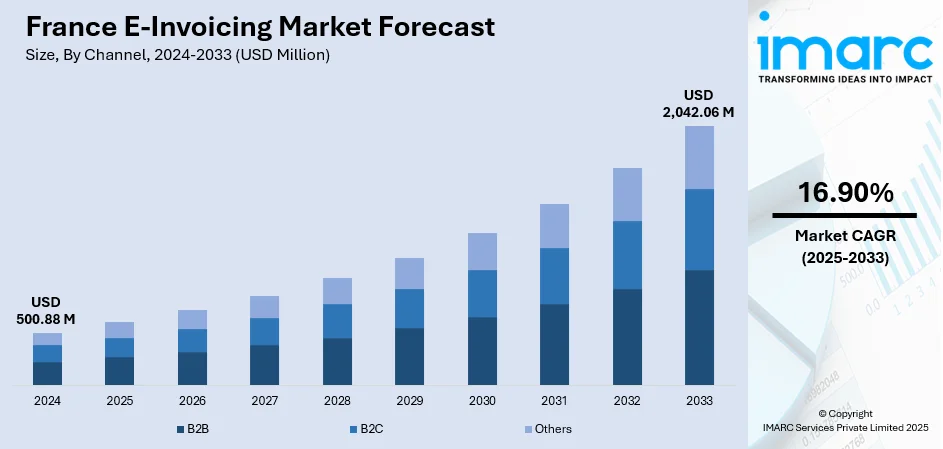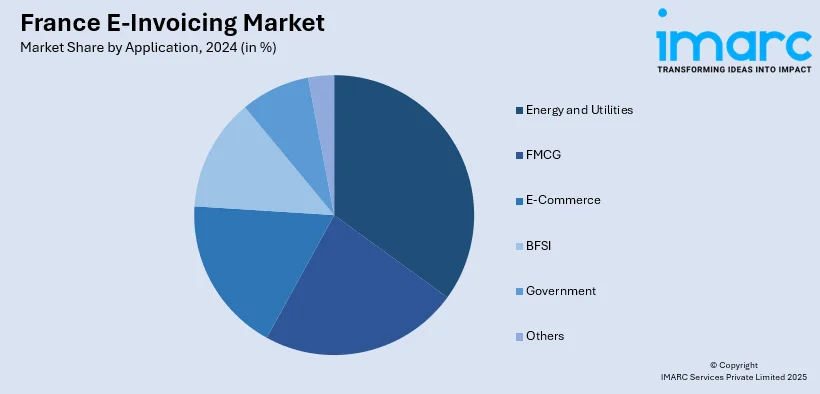
France E-Invoicing Market Size, Share, Trends and Forecast by Channel, Deployment Type, Application, and Region, 2025-2033
France E-Invoicing Market Overview:
The France e-invoicing market size reached USD 500.88 Million in 2024. Looking forward, the market is expected to reach USD 2,042.06 Million by 2033, exhibiting a growth rate (CAGR) of 16.90% during 2025-2033. The market is fueled by a phased regulation implementation, beginning with B2G and advancing to obligatory B2B and B2C compliance by 2027. The government's methodical approach also involves the utilization of certified private platforms and a national invoicing directory for automation and transparency. Standardized invoice structures and increasing digital maturity levels among French organizations further favor adoption. Coupled with the need for cross-border interoperability, such conditions are heavily boosting the France e-invoicing market share.
|
Report Attribute
|
Key Statistics
|
|---|---|
|
Base Year
|
2024
|
|
Forecast Years
|
2025-2033
|
|
Historical Years
|
2019-2024
|
| Market Size in 2024 | USD 500.88 Million |
| Market Forecast in 2033 | USD 2,042.06 Million |
| Market Growth Rate 2025-2033 | 16.90% |
France E-Invoicing Market Trends:
Government Reform and Structural Realignment
The French transition to e-invoicing is grounded in across-the-board government-initiated reforms, characterized by the ending of the original free Portail Public de Facturation (PPF) and the move towards a multi-party system employing accredited PDPs (Partner Dematerialisation Platforms). The government now targets the development of a centralized business directory and data concentrator, due for completion by September 2026, to facilitate automated VAT return pre-filling and audit readiness. This methodology allows invoice information in all forms to reach tax authorities effectively and maintains control and monitoring via the tax authority. The reform addresses previous technical and economic limitations associated with PPF development and supports a robust certification framework for PDPs. The resulting environment connects businesses with tax authorities through private, secure, interoperable platforms—a hybrid design that is distinctly French in its structure and public-private partnership.

To get more information on this market, Request Sample
Interoperability through Peppol and Standard Protocols
Using the Pan-European Public Procurement Online (Peppol) network in France prepares the nation for hassle-free domestic and cross-border invoice exchange. Peppol's certified framework is to be used by the tax authority to facilitate universal routing compatibility across service providers. The move away from point-to-point PDP connections to a Peppol-enabled "five-corner model" increases standardization, scale, and security. Alongside, France requires standardized invoice types—Factur-X, UBL, and CII—both machine-readable and human-readable. Together, all this puts France in a position to connect with larger EU e-invoicing networks, supporting compliance, trade, and digitalization in a way that is unique in the French technical and legislative environment, which further propels the France e-invoicing market growth.
Phased Adoption and SME Integration Challenges
France's e-invoicing plan uses a tiered approach to inclusion, starting in September 2026 with large and mid-corporations and rolling out to SMEs and micro-enterprises in September 2027. More than 70 PDPs are in the process of provisional certification, and interoperability tests have started to ensure cross-platform messaging. Several smaller businesses, however, are anxious about compulsory charges for access to PDPs and technical complexity. Companies now have decisions regarding the selection of appropriate PDPs, the upgrading of ERP systems, taking on Factur-X or UBL formats, and integration with the directory and data concentrator. Software suppliers and industry associations are offering pilot environments and interoperability toolkits to close this gap, and public outreach emphasizes efficiency benefits and fraud prevention. This consultative, phased process mirrors France's desire to balance its digital ambitions with inclusivity in its characteristic, developer-advised rollout of a uniquely structured system.
France E-Invoicing Market Segmentation:
IMARC Group provides an analysis of the key trends in each segment of the market, along with forecasts at the country and regional levels for 2025-2033. Our report has categorized the market based on channel, deployment type, and application.
Channel Insights:
- B2B
- B2C
- Others
The report has provided a detailed breakup and analysis of the market based on the channel. This includes B2B, B2C, and others.
Deployment Type Insights:
- Cloud-based
- On-premises
The report has provided a detailed breakup and analysis of the market based on the deployment type. This includes cloud-based and on-premises.
Application Insights:

- Energy and Utilities
- FMCG
- E-Commerce
- BFSI
- Government
- Others
A detailed breakup and analysis of the market based on the application has also been provided in the report. This includes energy and utilities, FMCG, e-commerce, BFSI, government, and others.
Regional Insights:
- Paris Region
- Auvergne-Rhône-Alpes
- Nouvelle-Aquitaine
- Hauts-de-France
- Occitanie
- Provence Alpes Côte d’Azur
- Grand Est
- Others
The report has also provided a comprehensive analysis of all the major regional markets, which include Paris Region, Auvergne-Rhône-Alpes, Nouvelle-Aquitaine, Hauts-de-France, Occitanie, Provence Alpes Côte d’Azur, Grand Est, and Others.
Competitive Landscape:
The market research report has also provided a comprehensive analysis of the competitive landscape. Competitive analysis such as market structure, key player positioning, top winning strategies, competitive dashboard, and company evaluation quadrant has been covered in the report. Also, detailed profiles of all major companies have been provided.
France E-Invoicing Market News:
- In June 2025, a guide document on 36 use cases and stakeholder roles for the September 2026 introduction of B2B e-invoicing was released by the AFNOR Standardization Commission. This covers the following: invoice transmission, rejections, disputes, billing circuit, billing address, and directory link. Included in this was the most recent XP Z12 e-invoicing standard, which aims to simplify B2B invoice interchange in accordance with changing fiscal requirements.
France E-Invoicing Market Report Coverage:
| Report Features | Details |
|---|---|
| Base Year of the Analysis | 2024 |
| Historical Period | 2019-2024 |
| Forecast Period | 2025-2033 |
| Units | Million USD |
| Scope of the Report |
Exploration of Historical Trends and Market Outlook, Industry Catalysts and Challenges, Segment-Wise Historical and Future Market Assessment:
|
| Channels Covered | B2B, B2C, Others |
| Deployment Types Covered | Cloud-based, On-premises |
| Applications Covered | Energy and Utilities, FMCG, E-Commerce, BFSI, Government, Others |
| Regions Covered | Paris Region, Auvergne-Rhône-Alpes, Nouvelle-Aquitaine, Hauts-de-France, Occitanie, Provence Alpes Côte d’Azur, Grand Est, Others |
| Customization Scope | 10% Free Customization |
| Post-Sale Analyst Support | 10-12 Weeks |
| Delivery Format | PDF and Excel through Email (We can also provide the editable version of the report in PPT/Word format on special request) |
Key Questions Answered in This Report:
- How has the France e-invoicing market performed so far and how will it perform in the coming years?
- What is the breakup of the France e-invoicing market on the basis of channel?
- What is the breakup of the France e-invoicing market on the basis of deployment type?
- What is the breakup of the France e-invoicing market on the basis of application?
- What is the breakup of the France e-invoicing market on the basis of region?
- What are the various stages in the value chain of the France e-invoicing market?
- What are the key driving factors and challenges in the France e-invoicing market?
- What is the structure of the France e-invoicing market and who are the key players?
- What is the degree of competition in the France e-invoicing market?
Key Benefits for Stakeholders:
- IMARC’s industry report offers a comprehensive quantitative analysis of various market segments, historical and current market trends, market forecasts, and dynamics of the France e-invoicing market from 2019-2033.
- The research report provides the latest information on the market drivers, challenges, and opportunities in the France e-invoicing market.
- Porter's five forces analysis assist stakeholders in assessing the impact of new entrants, competitive rivalry, supplier power, buyer power, and the threat of substitution. It helps stakeholders to analyze the level of competition within the France e-invoicing industry and its attractiveness.
- Competitive landscape allows stakeholders to understand their competitive environment and provides an insight into the current positions of key players in the market.
Need more help?
- Speak to our experienced analysts for insights on the current market scenarios.
- Include additional segments and countries to customize the report as per your requirement.
- Gain an unparalleled competitive advantage in your domain by understanding how to utilize the report and positively impacting your operations and revenue.
- For further assistance, please connect with our analysts.
 Request Customization
Request Customization
 Speak to an Analyst
Speak to an Analyst
 Request Brochure
Request Brochure
 Inquire Before Buying
Inquire Before Buying




.webp)




.webp)












